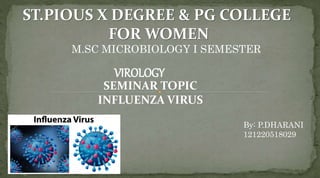
Influenza
- 1. ST.PIOUS X DEGREE & PG COLLEGE FOR WOMEN M.SC MICROBIOLOGY I SEMESTER VIROLOGY SEMINAR TOPIC INFLUENZA VIRUS By: P.DHARANI 121220518029
- 2. INTRODUCTION Belongs to orthomyxoviridae family & has 4 genera, they are influenza A, B, C& thogotoviruses. Influenza A can infect a variety of different host species & cause pandemic infection in man &1st isolated in 1933 by intranasal inoculation. Influenza B infects only humans and isolated along with type A in cell culture in 1940. Influenza C is a primary human infection but also isolated from pigs in china. Thogotoviruses is newly discovered 4th genus of orthomyxoviridae & are found in mosquitoes ,ticks & the banded mongoose. Most predominant feature of influenza virus is the ability to change antigenically either gradually(antigenic drift) or suddenly(antigenic shift). Only influenza A has the potential of antigenic shift. Influenza A, B, C can drift antigenically but minor changes are seen in ‘C’.
- 3. MORPHOLOGY Viruses are spherical, 80-120nm in diameter and may be filamentous. They have helical nucleocapsid comprising of A& B with 8 segments of ssRNA. Also contains viral RNA dependent RNA polymerase, which is essential for infectivity as viral RNA is of negative sense. Therefor it need to be transcribed as viral messenger RNA(mRNA). The nucleocapsid is surrounded by M1 protein shell and out of this shell there is a lipid layer derived from the host cell. The M2 protein projects through the envelop forming ion channels which allow pH changes in endosome. There are 2 types of species they are, haemagglutination(H) & neuraminidase(N).
- 4. The haemagglutinin is called because the virus agglutinates certain erythrocytes. They are of 10nm in length & contains glycoprotein subunits, each contain polypeptide chains HA1 & HA2. The 2 polypeptides are joined by a linkage site i.e., by single base or multibase. This virus binds to c ell by haemagglutinin by interacting with cell membrane receptor containing N –acetylneuramic acid (sialic acid). Epitopes show great variability due to mutation in RNA cause a.a substitutions at several sites of an HA1 molecule.
- 5. Between ‘H’ spikes, mushroom like projection is called as neuraminidase & is important in final stage of release of new virus particles from infected cell. It can withstand slow drying at room temperature & can survive in cold sea H2O for several weeks. It can be preserved for long period at -70⁰ & remain viable when freeze dried. Exposure to heat for 30mins at 50⁰ is sufficient to inactivate strain & 90mins to kill. Virus can be inactivated by 20% ether in cold, phenol, formaldehyde, salt of heavy metals, detergents, soaps ,etc. PATHOGENISIS Pathogenicity of influenza is multifactorial & involve viral, host & environmental factors. Avian strains is identified host receptor & protease as determinants of tropism. Human strains are monobasic with HA1/HA2 joints with trypsin like proteases . Neuraminidase allows the virus to break the bond. IgA antibodies if present from previous infection, may neutralize the virus before it attaches.
- 6. The interferon’s produced from infected cell diffuse into both adjacent & distinct cells before virus arrives & protects them. There are 3types of influenza: they are I. Influenza A: incubation period is short and symptoms are like chill, fever, headache, Myalgia & anorexia. Many patients show upper & lower respiratory infection. Fever last for 3-5days, during 2nd & 3rd day of illness, the systematic effects diminish, 4th & 5th day respiratory signs & symptoms are seen. In adults, systematic illness without respiratory symptoms is common. II. Influenza B: symptoms closely resemble associated with influenza A. It shows 3days febrile illness with systemic symptoms. III. Influenza C: causes afebrile upper respiratory infection confined to young children and outbreaks are not recognized.
- 7. DIAGNOSIS 1. Viral association & detection: for isolation, 2⁰ baboon kidney cells (or) Madin - Darby canine kidney cells are used. • The presence of virus maybe detected in baboon kidney cells when incubated at 33⁰C after 18hrs if incubation by haemadsorption with human ‘O’ group (or) guinea pig RBC. • In clinical specimens, virus can be isolated with in 7days by immunofluorescence method. 2. Rapid diagnosis: immunofluoroscent detection of influenza antigen in respiratory system either directly after amplification in cell culture for 24hrs. • Nasal aspirates or nasal washes are best specimens.
- 8. EPIDEMOLOGY Epidemics caused by influenza virus have been described for more than 2000yrs. Pandemic are recognized at various intervals. The great pandemic of 1918-1919 was severe, killing 20-40 million people. It is possible to deduce which viral antigen circulated before virus isolation became possible. Major pandemics are associated with antigenic shifts i.e. when the viral H (or) N (or) both change. If a cell is infected with 2 different strains, the progeny will include both the parental RNA molecules. All the H & N antigen subtypes are formed in aquatic birds. INFLUENZA B: this virus do not undergo antigenic shift as there is no animal reservoirs. Epidemic occurs every 3-6yrs interval and they do not become pandemic. INFLUENZA C: they are not associated with epidemics but give rise to respiratory infections in young children and are asymptomatic.
- 9. TREATMENT Oral amantadine hydrochloride was derived from rimantadine in early 1980’s & worked only on influenza A, this will block ion channels &thus prevent pH changes. Amantadine is effective when given prophylactically & therapeutically when given within 24hrs of administration. Zanamivir & oseltamivir are the neuraminidase inhibitors & are effective against influenza A & B. These are effective against amantadine or rimantadine resistant strains.